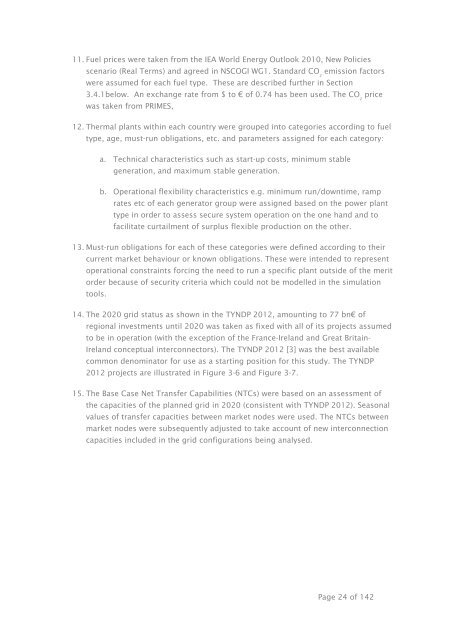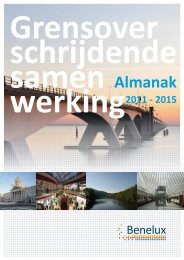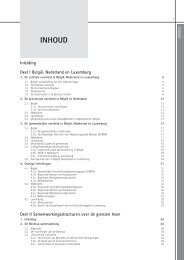The North Seas Countries' Offshore Grid Initiative - Initial ... - Benelux
The North Seas Countries' Offshore Grid Initiative - Initial ... - Benelux
The North Seas Countries' Offshore Grid Initiative - Initial ... - Benelux
Create successful ePaper yourself
Turn your PDF publications into a flip-book with our unique Google optimized e-Paper software.
11. Fuel prices were taken from the IEA World Energy Outlook 2010, New Policies<br />
scenario (Real Terms) and agreed in NSCOGI WG1. Standard CO emission factors<br />
2<br />
were assumed for each fuel type. <strong>The</strong>se are described further in Section<br />
3.4.1below. An exchange rate from $ to € of 0.74 has been used. <strong>The</strong> CO price<br />
2<br />
was taken from PRIMES,<br />
12. <strong>The</strong>rmal plants within each country were grouped into categories according to fuel<br />
type, age, must-run obligations, etc. and parameters assigned for each category:<br />
a. Technical characteristics such as start-up costs, minimum stable<br />
generation, and maximum stable generation.<br />
b. Operational flexibility characteristics e.g. minimum run/downtime, ramp<br />
rates etc of each generator group were assigned based on the power plant<br />
type in order to assess secure system operation on the one hand and to<br />
facilitate curtailment of surplus flexible production on the other.<br />
13. Must-run obligations for each of these categories were defined according to their<br />
current market behaviour or known obligations. <strong>The</strong>se were intended to represent<br />
operational constraints forcing the need to run a specific plant outside of the merit<br />
order because of security criteria which could not be modelled in the simulation<br />
tools.<br />
14. <strong>The</strong> 2020 grid status as shown in the TYNDP 2012, amounting to 77 bn€ of<br />
regional investments until 2020 was taken as fixed with all of its projects assumed<br />
to be in operation (with the exception of the France-Ireland and Great Britain-<br />
Ireland conceptual interconnectors). <strong>The</strong> TYNDP 2012 [3] was the best available<br />
common denominator for use as a starting position for this study. <strong>The</strong> TYNDP<br />
2012 projects are illustrated in Figure 3-6 and Figure 3-7.<br />
15. <strong>The</strong> Base Case Net Transfer Capabilities (NTCs) were based on an assessment of<br />
the capacities of the planned grid in 2020 (consistent with TYNDP 2012). <strong>Seas</strong>onal<br />
values of transfer capacities between market nodes were used. <strong>The</strong> NTCs between<br />
market nodes were subsequently adjusted to take account of new interconnection<br />
capacities included in the grid configurations being analysed.<br />
Page 24 of 142










